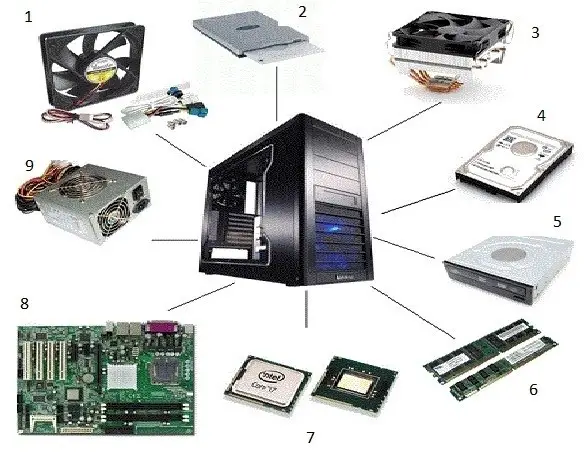Intorduction To CPU Parts And Functions

1 – System fan. This type of cooling fan is normally mounted at the back of the CPU and sometimes on the sides of the CPU case depending on the model of the CPU. By default, this cooling fan is connected to the system fan pins on the motherboard. But sometimes this is not followed. They connect it to the power supply connectors.
If this fan is connected to the motherboard, it will operate depending on the setting on the BIOS. But if it is connected directly to the power supply connector, the cooling fan permanently operates at normal speed.
2 – Floppy disk drive. This type of drive is made obsolete when USB flash drives are released for public use. This type of storage is popular during the days of DOS and Windows 32 when all computers are still slow.
3 – CPU cooling fan. By default, the CPU cooling fan is always mounted on top of the heat sink to maintain the temperature of the processor. The heat sink, on the other hand, is mounted on top of the processor in direct contact. The heat sink absorbs all the heat produced by the processor. The cooling fan then lowers down the temperature of the heat sink by blowing cool air.
The CPU cooling fan and heat sink operates in pair and cannot work if the other one is missing. For example, if the CPU cooling fan is not available, the processor will overheat even if the heat sink is mounted because there is no means to lower down the temperature of the heat sink.
Likewise, if the heat sink is not available, the CPU cooling fan is not enough to lower down the temperature of the processor because there is no object that has direct contact with the processor to absorb the heat.
4 – Hard drive. This is the default storage of the computer where the operating system is installed or where Microsoft Windows is installed. The hard drive can be internal or external. If the hard drive is an external type, it is used by connecting it to the USB port of the CPU using its USB cable.
5 – Optical drive. This can be a CD-ROM, CD-writer, DVD-ROM, DVD-writer, or Blu-ray ROM DVD-writer. Depending on the model of the CPU and the availability of the port on the motherboard, multiple optical drives can be installed. A CD-ROM, DVD-ROM, and Blu-ray ROM can only read discs. A CD-writer and a DVD-writer can burn data to a disc. A CD-writer is limited only to CD-R or CD-RW discs.
A DVD-writer can burn data to a CD-R, CD-RW, DVD-R, and DVD-RW.
6 – Memory card. This is the physical RAM of the computer. When booting a computer, parts of the operating system or the system files of the operating system are loaded into the memory and remains there until the computer is turned off. When the computer is turned off, all the information on the physical RAM are gone.
Two types of memory are being used simultaneously when the computer is running, the physical RAM and the virtual RAM. This is done to balance the load on the system. The virtual RAM is also called the page file or swap file which appears as a file on the system drive.
Though this type of memory is in a form of a file, no data or information is stored when the computer is turned off. These two types of memory also differ in speed in terms of data access. Data transfer or data access in the virtual memory is slower than the physical memory. The physical memory is the fastest of the two.
7 – Processor. This is the brain of the computer that does all the thinking and processing.
8 – Motherboard. If the processor is the brain or the head of the computer, the motherboard is the body. This is where all the components and devices are connected like the physical RAM, graphics adapter, floppy disk drive, optical drive, hard drive, network card, sound card, keyboard, mouse, and others.
9 – Power supply. This is the component that is responsible for supplying the power to the entire system. Without this, the computer will not run. It converts the AC power from the power outlet to DC power in different voltages. The six colors of the power supply cable denote different voltage ratings. The orange cable supplies +5 volts which is for power good signal.
The red cable supplies +5 volts for the TTL ICs. The yellow cable supplies +12 volts for the motherboard, CMOS ICs, and motor. The blue cable supplies -12 volts for the motherboard. The white cable supplies -5 volts also for the motherboard. The black cable supplies the ground signal.














